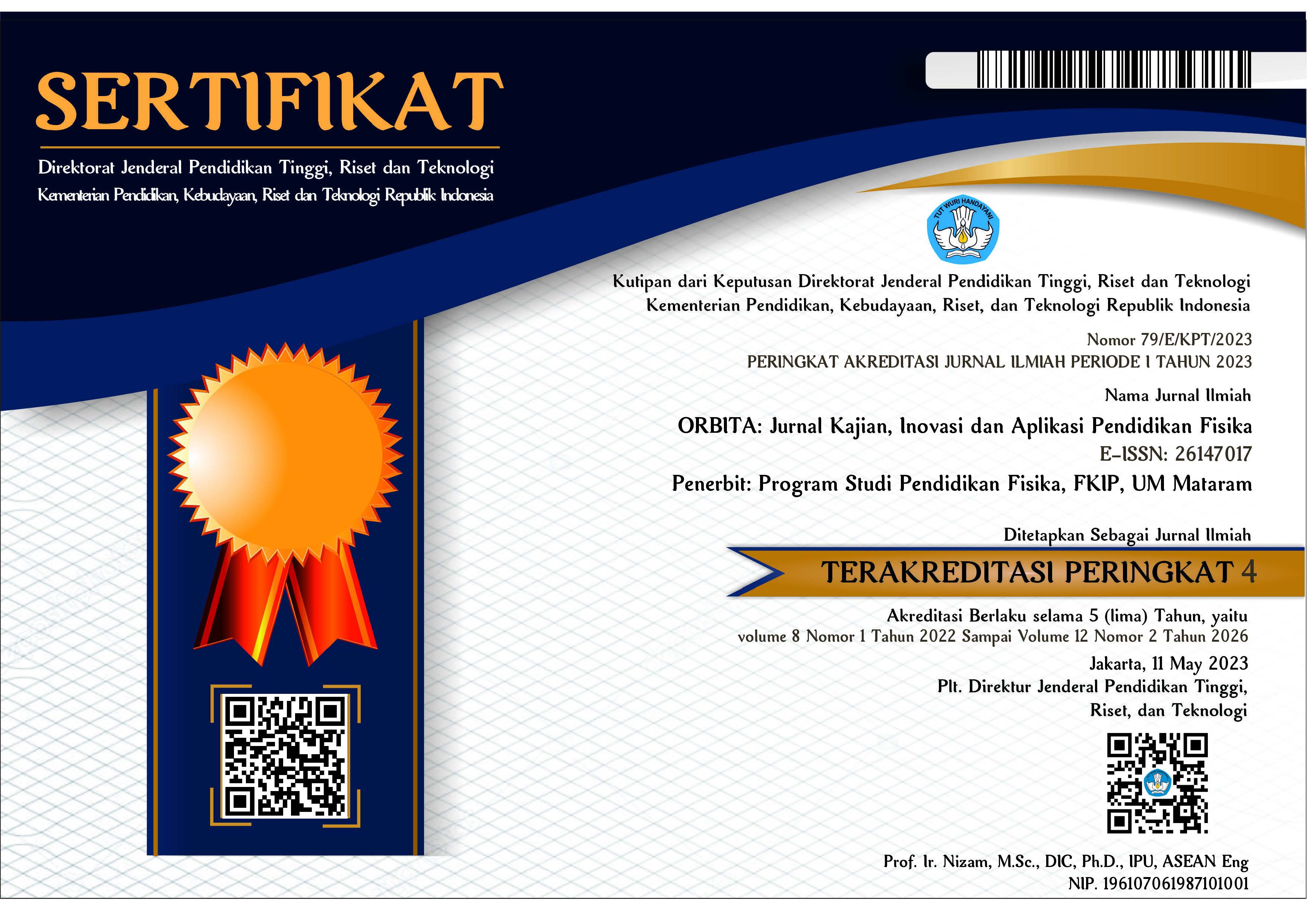Reducing the quantity of students who have misconceptions about archimedes' law material using the Children Learning in Science (CLIS) model
Abstract
This research aims to determine the decrease in the quantity of students who have misconceptions about Archimedes' law material after the CLIS learning model has been implemented, determine student responses to the CLIS learning model that has been implemented, and determine the implementation of learning activities using the CLIS model. The research was carried out using quantitative methods. The population in this research was all students of class XI IPA MAN 1 Singkawang. The data in the research was obtained by giving sheets to the students. The instruments used were a TTT sheet consisting of 10 questions, a student response sheet with 9 questions, an observation sheet on the implementation of the CLIS learning model. Based on the results of the analysis of students' misconceptions, the highest decrease was in the concept "Objects sink in water because objects are heavier than water" namely 64.2% in the medium category. Student response to the CLIS learning model was 85% in the positive category. The implementation of the CLIS learning model is 100% with all activities carried out in the category. Therefore, it can be concluded that implementing CLIS can reduce the quantity of students who have misconceptions.
Keywords
Full Text:
PDFReferences
Anwar, Muzikka. ahmad hamid, Wahyuni, A., & Hamid, A. (2017). Penerapan Pembelajaran (Children Learning In Science) untuk meningkatkan hasil belajar siswa. Jurnal Ilmiah Mahasiswa (JIM) Pendidikan Fisika, 1(4). https://jim.usk.ac.id/pendidikan-fisika/article/view/2221/1130
Dewi, I. N. A., Kusairi, S., & Yuliati, L. (2016). Miskonsepsi Siswa Sma Pada Materi Hukum Archimedes. https://lib.um.ac.id/wp-content/uploads/2017/09/Miskonsepsi-Siswa-SMA-Pada-Materi-Hukum-Archimedes.pdf
Fitria, E. (2022). Remediasi Miskonsepsi Materi Tekanan Zat Cair Pada Siswa Sma Negeri 3 Halmahera Timur Dengan Model Pembelajaran Children Learning In Science (Clis) Berbantuan Simulasi PhET. Jurnal Ilmiah Wahana Pendidikan. https://jurnal.peneliti.net/index.php/JIWP/article/download/2907/2252/
Hermansyah. (2014). Penerapan Model Levels Of Inquiry Berbantuan Tutor Sebaya Untuk Meningkatkan Hasil Belajar Siswa SMA Pada Pembelajaran Fisika [Universitas pendidikan Indonesia]. https://repository.upi.edu/12625/
Hikmat, Yuyu R. Tayubi, Unang Purwana, & Andi Suhandi. (2014). Strategi Konflik Kognitif Berbantuan Media Simulasi Virtual dalam Pembelajaran Fisika Berorientasi Pengubahan Konseptual untuk Meningkatkan Pemahaman Konsep dan Menurunkan Kuantitas Siswa yang Miskonsepsi. Strategi Konflik Kognitif Berbantuan Media Simulasi Virtual Dalam Pembelajaran Fisika Berorientasi Pengubahan Konseptual Untuk Meningkatkan Pemahaman Konsep Dan Menurunkan Kuantitas Siswa Yang Miskonsepsi. https://adoc.pub/download/kata-kunci-strategi-konflik-kognitif-media-simulasi.html
Kemendikbud. (2014). Lampiran peraturan menteri pendidikan dan kebudayaan RI nomor 59 tahun 2014 tentang kurikulum 2013 sekolah menengah atas/madrasah aliyah. Kementerian Pendidikan dan Kebudayaan.
Lestari, A. (2022). Penerapan Media Nyata Untuk Mengatasi Kesalahan Konsep Ipa Pada Materi Gaya Dalam Air Di Kelas Iv Sdn 05 Pagi. https://prosiding.esaunggul.ac.id/index.php/snip/article/viewFile/263/257
Lestari, P. A. S., Satutik, R., & Hikmawati. (2015). Profil Miskonsepsi Siswa Kelas X SMKN 4 Mataram Pada Materi Pokok Suhu, Kalor, dan Perpindahan Kalor. Jurnal Pendidikan Fisika Dan Teknologi, 1(3). https://jurnalfkip.unram.ac.id/index.php/JPFT/article/view/251
Rahayu, E. S. (2015). Aplikasi Model CLIS (Children’s Learning In Science) Untuk Meningkatkan Kreativitas Belajar Kimia Siswa Kelas X MAN Tulungangung 1 Melalui Pembuatan Briket Sampah Organik Jurnal Review Pendidikan Islam. Jurnal Review Pendidikan Islam, 1(2). https://adoc.pub/download/jurnal-review-pendidikan-islam-volume-01-nomor-02-desember-278f652a1279f44265a962416f00a4eb438469.html?reader=1
Sumarli. (2018). Analisis Model Pembelajaran Tipe Think-Pair-Share Berbasis Pemecahan Masalah Terhadap Keterampilan Berpikir Tingkat Tinggi Siswa. Jurnal Ilmu Pendidikan Fisika, 3(1). https://scholar.google.com/citations?view_op=view_citation&hl=id&user=LToe9yEAAAAJ&citation_for_view=LToe9yEAAAAJ:2osOgNQ5qMEC
Sumarli, Nugroho, S. E., & Yulianti, I. (2018). Keefektifan Model Pembelajaran Creative Problem Solving Berpendekatan Inquiry terhadap Keterampilan Proses Sains Siswa [Universitas Negeri Semarang]. https://scholar.google.com/citations?view_op=view_citation&hl=id&user=LToe9yEAAAAJ&citation_for_view=LToe9yEAAAAJ:qjMakFHDy7sC
Suparno, P. (2005). Miskonsepsi & Perubahan Konsep Pendidikan Fisika. Grasindo.
Suparno, P. (2013). Miskonsepsi dan Perubahan Konsep dalam Pendidikan Fisika. Gramedia Widiasarna Indonesia.
Suryawirawati, I. G., Ramadhan, B., & Juhanda, A. (2018). Analisis Penurunan Miskonsepsi Siswa Pada Konsep Pemanasan Global Dengan Tes Diagnostik (Two-Tier Test) Setelah Pembelajaran Predict-Observe-Explain (POE). 1(1). https://journal.iainkudus.ac.id/index.php/jbe/article/view/3361/pdf
DOI: https://doi.org/10.31764/orbita.v10i1.22543
Refbacks
- There are currently no refbacks.

This work is licensed under a Creative Commons Attribution-ShareAlike 4.0 International License.
______________________________________________________
ORBITA: Jurnal Pendidikan dan Ilmu Fisika
p-ISSN 2460-9587 || e-ISSN 2614-7017
This work is licensed under a Creative Commons Attribution-ShareAlike 4.0 International License.
EDITORIAL OFFICE:


























